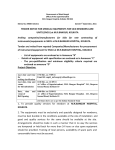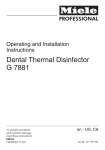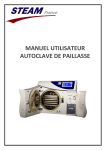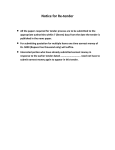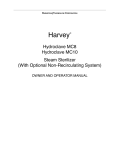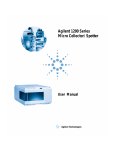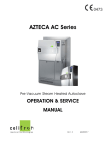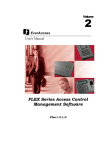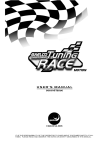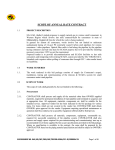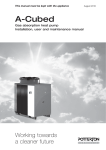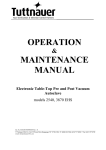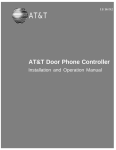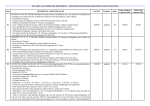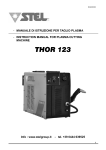Download STING11
Transcript
STING 11 Pre and Post Vacuum- Table Top Autoclave OPERATION & SERVICE MANUAL QA060004 TABLE OF CONTENT 1. 2. 3. 4. 5. PARAGRAPH PAGE NO. General 1.1 Incoming Inspection…………………………………………………. 4 1.2 Warranty………………………………………………………………… 4 General Information 2.1 Introduction……………………………………………………………. 6 2.2 Operating Conditions………………………………………………… 7 2.3 Utilities…………………………………………………………………… 7 2.4 Environment Emission Information ………………………………… 8 2.5 Electromagnetic Compatibility (EMC)…………………………….. 8 2.6 Symbol Description…………………………………………………... 9 2.7 Specifications…………………………………………………………. 10 2.8 Construction…………………………………………………………… 11 2.9 Water quality…………………………………………………………... 12 2.10 Directives and Standards……………………………………………. 13 2.11 Storage and Transportation………………………………………… 13 2.12 Detailed Interface of the Autoclave……………………………… 14 2.13 Safety devices………………………………………………………... 16 Electronic Control System Sting 11 (Rose) 3.1 General………………………………………………………………… 17 3.2 Digital Board Rose-D…………………………………………………. 18 3.3 Analog Board Rose-A………………………………………………… 19 3.4 AC Board Rose-P……………………………………………………… 20 Cycles Descriptions 4.1 Cycle 1 - (Flash 134)………………………………………………… 22 4.2 Cycle 2 - (Unwrapped 134)………………………………………… 23 4.3 Cycle 3 - (Wrapped 134)…………………………………………… 24 4.4 Cycle 4 - (Prion)……………………………………………………… 25 4.5 Cycle 6 - (Porous)……………………………………………………. 26 4.6 Cycle 8 - (BD Test)…………………………………………………… 27 4.7 Cycle 9 - (Vacuum Test)……………………………………………. 28 UGI (User Graphic Interface) description 5.1 Foreword……………………………………………………………… 29 5.2 UGI overview…………………………………………………………. 29 5.3 Main Screen………………………………………………………….. 29 5.4 On Process Screen………………………………………………….. 32 5.5 Keys on the Main Screen…………………………………………… 33 5.6 System Setup…………………………………………………………. 34 5.7 System messages…………………………………………………… 53 Page 1 of 82 TABLE OF CONTENT (Cont.) PARAGRAPH PAGE NO. 6. Printer 6.1 Printer Operation……………………………………………………… 59 6.2 Printer Output…………………………………………………………. 60 6.3 Printer Specification and Handling………………………………… 61 7. Installation 7.1 Placing…………………………………………………………………. 63 7.2 Power Connection…………………………………………………… 63 7.3 Protective Earthing…………………………………………………… 64 7.4 Lifting and carrying………………………………………………….. 64 7.5 Loading and unloading the Device………………………………. 64 7.6 Filling the Water Reservoir…………………………………………… 65 8. Preparation before Sterilization…………………………………………… 66 9. Operating Instructions………………………………………………………. 68 10. Maintenance Instructions 10.1 Preventive and Scheduled Maintenance……………………….. 69 10.2 Draining the Reservoir……………………………………………….. 71 10.3 Replacing the Air Filter……………………………………………… 72 10.4 Replacing the Door Gasket………………………………………… 73 10.5 Replacing the Cartridge Fuse……………………………………… 73 10.6 Checking the Safety Valve…………………………………………. 74 10.7 Door Safety System…………………………………………………... 75 10.8 Cleaning water strainer……………………………………………… 75 10.9 Replacing the Exhaust Filter in the Chamber……………………. 76 11. Accessories……………………………………………………………………. 77 12. Spare Parts List……………………………………………………………….. 78 13. Troubleshooting………………………………………………………………. 79 Appendix 1 Appendix 2 Electrical Schematics diagram of the Autoclave…………… 81 Piping Schematics diagram of the Autoclave………………. 82 Page 2 of 82 DRAWINGS PAGE NO. Overall Dimensions………………………………………………………….. 11 Front View……………………………………………………………………… 14 Rear View……………………………………………………………………… 15 Rose Control System………………………………………………………… 17 Rose-D Board…………………………………………………………………. 18 Rose-A Board…………………………………………………………………. 19 Rose-P Board…………………………………………………………………. 20 Water Reservoir………………………………………………………………. 65 Tray…………………………………………………………………………….. 66 Tray with Tubing……………………………………………………………… 67 Draining Water Reservoir…………………………………………………… 71 Replacing Air Filter………………………………………………………….. 72 Replacing Door Gasket…………………………………………………….. 73 Safety Valve…………………………………………………………………… 74 Exhaust Filter………………………………………………………………….. 76 Tray handle……………………………………………………………………. 77 Tray……………………………………………………………………………… 77 Tray holder……………………………………………………………………. 77 Page 3 of 82 1. General The Autoclave should be used as described in this manual only. The following are the Instruction before operating the autoclave: 1.1 Incoming Inspection Immediately upon reception of your product, examine the packaging material and contents for shipment damage (such as: scratched panel surfaces, broken knobs, etc). Report any such instance to your dealer or point of purchase. All Celitron Medical Technologies Kft. products are tested and inspected prior to shipment. 1.2 Warranty Celitron Medical Technologies Kft. warrants that the equipment has been carefully tested and inspected and has left the factory in proper working conditions, free of visible defects. Celitron Medical Technologies Kft. warrants the equipment to be free from defects in material and workmanship, under normal use and operation, for a period of one (1) year from the date of initial installation, or demonstration; or eighteen (18) months from the date of shipment from the factory; or whichever occurs first. Celitron Medical Technologies Kft. warrants the pressure vessel for a 10 years period if used under Celitron Medical Technologies Kft. instructions, found in this operation manual and under these conditions. : The components of equipment guaranteed will include only those components which are not considered expendable. Door gaskets, bulbs, heating elements, etc., will not be guaranteed by Celitron Medical Technologies Kft. : The liability of Celitron Medical Technologies Kft. is limited to the replacement of the defective part or component. : Celitron Medical Technologies Kft. cannot guarantee the replacement of parts which are defective because of damage in transit, pilferage, or parts of equipment which have been improperly used or maintained. Page 4 of 82 Note: In case you meet some difficulties and you do not find the solution in the manual: : Contact our representative. : Inform him with model and serial number of the autoclave : Describe the difficulty. For autoclave built with a printer: send a copy of the last printout. Reparation is accepted after getting authorization from the company. Shipment (both ways): all costs are paid by the owner. We accept this guaranty only if the unit is purchased from an authorized full service dealer. DO NOT SERVICE THE UNIT BY YOURSELF! Remarks: : The warranty does not include and does not replace routine treatment and preventive maintenance. : Details of our Technical Service Department: Celitron Medical Technologies Kft. 2600 Vác Avar utca 5 Hungary Phone: +36 27 512 267 Fax: +36 27 512 268 [email protected] Page 5 of 82 2. General Information 2.1 Introduction This table-top autoclave is designed for sterilization of medical and surgical materials such as unwrapped and wrapped, solid, hollow and porous products and goods that are defined as hollow in ophthalmic dental and medical clinics, first aid rooms, small laboratories, etc. This autoclave model is an electrically heated sterilizer using steam as a sterilizing agent. The autoclave is classified as Class IIa according to MDD 93/42/EEC. The autoclave is designed as a Small Steam Sterilizer Type B in accordance with EN13060 and as Class I in accordance with EN60601-1, continuously operated, ordinary equipment without applied parts and without signal input-output parts. The device is not intended for use in the presence of flammable mixtures. This model is a pre-vacuum sterilizer having the following features; : An air removal stage (pre-vacuum), before starting the sterilizing stage. : A post-sterilization drying phase, based on the combined operation of heat and vacuum with air inlet pulses. In order to improve the efficiency of the vacuum pump – capability and speed– a heat exchanger is installed on the outlet piping of the chamber. The steam and condensate evacuated from the chamber pass through a cooling coil immersed in the water reservoir. The advantages of the pre-vacuum sterilizer are as follows: : Removal of air pockets from packs and porous load and most kinds of hoses (rubber, plastic etc.) by vacuum at the first stage of the cycle. : Better steam penetration into the load; resulting in effective sterilization. : Better temperature uniformity. : Better drying of materials due to the vacuum achieved in the chamber at the end of the sterilization cycle. A printer is an optional addition to the autoclave. The printer prints the preset and actual parameters of the cycle (temperature, time and pressure/ vacuum). Page 6 of 82 This manual is intended for the user and gives the user a general understanding of the instrument and the best ways to operate and take care of it in order to obtain effective results. After reading this manual, operating the autoclave will be easy. However since this instrument is built with high technology sensitive components, no attempt should be made by the user or any other unauthorized person to repair or recalibrate it. Only technical personnel having proper qualifications and holding technical documentation (including a technician manual) and adequate information are authorized to service the device. 2.2 Operating Conditions : This device is for indoor use only! : The sterilizer should be loaded only with autoclavable material! : The environment shall not exceed an ambient temperature of 40ºC and a relative humidity of 85% respectively. : The operation altitude shall not be over 2000 meters (ambient pressure shall not be lower than 80 kPa (11.6 psi)). : It is recommended to perform a B & D cycle at the beginning of each working day. Caution! Only non-hazardous liquids shall be disposed in public sewage! 2.3 Utilities Utility Value Power supply 1 phase, 220V – 13A, 50 Hz Protection against electrical shock Class I (IEC 60601-1) Page 7 of 82 2.4 Environment Emission Information : The peak sound level generated by the autoclave is less than 70 db A with background noise of 60 db A. : The total heat per hour transmitted by the autoclave is < 100 Wh. : The Autoclave is not a source of electromagnetic emissions for medical purposes. The level of the EMC Emissions was tested by a certified laboratory according to the list of relevant standards (see clause 2.10), and found to be in compliance with the requirements. 2.5 Electromagnetic Compatibility (EMC) The installation and the service of the sterilizer should consider special precautions regarding EMC according to the information accompanying in this user and service manual. (According to standard EN 60601-1-2 paragraph 6.8.2.201-Instructions for use). : Warning- The use of cables, pumps, transducers or any other electrical elements other than those specified by Celitron Medical Technologies as replacement parts may result in increased EMMISIONS or decreased IMMUNITY of the sterilizer. : Warning- the sterilizer should not be used adjacent to or stacked with other equipments. : Warning-the sterilizer should not be connected to the same power line with other equipments. : Warning-Portable and mobile RF communications equipment such as cellular phones can affect the operation of the sterilizer. Page 8 of 82 2.6 Symbol Description This sign indicates the need of caution. Read accurately all the notes beside this sign. This sign informs about hot surface. This sign points to the Grounding connection This sign points Danger of High Voltage. Page 9 of 82 2.7 Specifications Item Parameter Value Chamber Inner Dia. 261.0 mm (10.3") Depth 452.0 mm (17.8") Chamber volume 23 lit. (6.1 gal) External dimensions Width (A) 53.4 cm (21.0") Height (B) 47.5 cm (18.7") Length (C) 60.9 cm (23.9") Weight (net) 60 kg (132.2 lb) Shipping weight 70 kg (152.1 lb) Shipping dimensions Width 64 cm (25.2") Height 58 cm (22.8") Length 72 cm (28.3") Maximum dimensions (door open) Length 92.0 cm (36.2") Distance between supporting legs R-rear legs F-front legs K 46.1 cm (18.1") R 48.1 cm (18.9") F 48.1 cm (18.9") Mineral free water reservoir volume 6 lit. (1.32 gal) Maximum load for tray 2.0 kg (4.4 lb) Maximum solid load 6.0 kg (13.2 gal) Maximum textile load 2.0 kg (4.4 lb) Max. Working pressure 2.7 bar (39 psi) Min. Working pressure -0.9 bar (-13.5 psi) Tray dimensions W 18.4 cm (7.2") H 2.0 cm (0.78") L 39.0 cm (11.4") No. of trays 4 IMS cassettes (optional) 4 Heaters power 2900W The installation category over voltage category II Pollution degree 2 Voltage fluctuation ±10% Max. Water temp. at the reservoirs 65ºC (149ºF) Max. total Heating spread in 1 hour 4325 kJ Max. support Load with full reservoirs and Generator & Coil 29 n/cm² Max. support Load with full reservoirs, chamber and Generator & Coil 34 n/cm² Min. water quantity allowing the cycle 1L Max. Water consump. during the cycle 0.6 L Max. Total cycle time 75 min Peak sound level 65dB Page 10 of 82 24.0 451.0 47 5.0 2.7.1 Overall Dimensions 609.0 518.0 534.0 91.0 2.8 Construction The main parts of the autoclave are made of materials as indicated below: : Chamber is built of stainless steel 316 Ti. : Door is made of Aluminum A356-T6 Din 725-86 (G-ALSI7 Mg). : Trays are made of stainless steel 304. : Water reservoir is made of Polyethylene Linear (LLDPE) UL-94 V2. Page 11 of 82 2.9 Water quality The mineral– free water supplied to the autoclave should have the physical characteristics and maximum acceptable level of contaminants indicated in the table below: Physical characteristics and acceptable contaminants levels in water, for sterilizers: Evaporate residue ≤ 15 mg/l Silica ≤ 2 mg/l Iron ≤ 0.2 mg/l Cadmium ≤ 0.005 mg/l Lead ≤ 0.05 mg/l Rest of heavy metals ≤ 0.1 mg/l Chloride ≤ 3 mg/l Phosphate ≤ 0.5 mg/l Conductivity ≤ 50 μs/cm pH 6.5 to 8 Appearance Hardness colorless, clean, without sediment ≤ 0.1 mmol/l Compliance with the above data should be tested in accordance with acknowledged analytical methods, by an authorized laboratory. Page 12 of 82 2.10 Directives and Standards: Technical Standards : Pressure Equipment Directive 97/23/EC (PED) Essential safety requirements, Annex I, 7.4. : Medical Device Directive 93/42/ EEC. : EN 60601-1:1990+ A1:1993 +A2:1995 +A13:1996 (Dir. 93/42/EEC) : IEC 60601-1:1998 +A1:1991 : EN 61010-1:01– Safety of electrical equipment- General requirement. : UL 61010A-1:2002 : IEC 61010-1:2001 : EN 61010-2-041:96 (Dir 73/23/EEC)– Safety of electrical equipment. : EN 61010-2-041:95 – Particular requirement for steam autoclaves. : EN 61326 (Dir. 89/336/EE) – (EMC) Emission compatibility. : EN 60601-1-2:01 (Dir.93/42/EEC) – (EMC) Immunity compatibility. : EN 13060:2005– Small Steam Sterilizers. : EN 554 (94)– Sterilization and Validation Quality standards The company's management system meets the following quality standards: : ISO 9001:2000– Quality Management System- Requirements. : ISO 13485:2003 – Quality systems – Medical devices – Particular requirements for the application of ISO 9001. : EN ISO 14971 –Risk Management for Medical device. 2.11 Storage and Transportation Conditions : The environment ambient temperature should be in the range of 050ºC and a relative humidity of 85% respectively. : The storage and transportation altitude shall not be over 2000 meters (ambient pressure shall not be lower than 80 kPa (11.6 psi)). : Equipment may be moved only with empty Water Reservoirs. Page 13 of 82 2.12 Detailed Interface of the Autoclave Front View: 1 9 2 3 7 8 10 6 12 No. 11 13 4 5 Description N0. Description 1 Trays Holder (Fig. 29) 8 Air Filter 2 Tray 9 Fill water to reservoir 3 Door locker 10 RS232 PC communication port 4 Exhaust Filter 11 Leg 5 Water Reservoir Drainage 12 Door 6 Printer cover 13 7 Operator Panel Page 14 of 82 Chamber Rear View 3 2 1 No. Description N0. 1 Rear Cover 4 2 Electrical Power panel 5 3 Leg Page 15 of 82 4 5 Description Over Flow Optional-exhaust to external Reservoir Electrical Power panel No. Description 1 Main Power switch 2 Power Inlet 3 Fuses 15 A 2.13 Safety devices : Thermostat Ty95-HS of Campini Corel Inc. This safety component interrupt heating element in case of the temperature above 170ºC. In order to precede the work, the user needs to push the reset button. : Safety Valve of Herose Type 06205. This safety component releases the pressures above 2.7 BAR. Page 16 of 82 3. Electronic Control System STING 11 (Rose) 3.1 General STING 11 control system contains all the necessary resources for operating the Autoclave. Inside the system there are 3 electronic boards: Digital board (Rose-D), AC and Power board (Rose-P), Analog board (RoseA). The boards are connected to each other according to their functions (see drawing): Fig. 1 : The system has an ability to operate 11 24VAC valves, 4 high AC devices in medium power consumption (Pumps), and 1 high AC outputs in high power consumption (Heaters), to accept 8 digital inputs (floats, door switches, etc.), and to measure many kinds of analog inputs (PT100 sensor, Pressure sensor, Water electrodes etc.). : The system is equipped with a serial communication that can be connected to a personal computer & local printer. : The System has a Graphic display and touch screen for the user interface. Page 17 of 82 3.2 Digital Board Rose-D. Digital board – Rose-D is the main processing board in the system. The following are the basic components of this board: : Micro Controller: the engine of the board. Its function is to run the process and interact with the user interface (touch screen, display, PC communication etc.). : Memories: The Memories are an important auxiliary tool for the Micro Controller. There are three types of memories: 1. Flash Memory: this memory is designated to save the software, all of the tables, parameters, calibration data, languages fonts, and a memory space for Logging. 2. RAM: this memory is designated to temporarily save all the variables in the software. 3. Real Time Clock & Non Volatile Memory: this component provides all of the clock's requirements and stores all required parameters. Fig. 2: Rose-D Board : Communication: The Control System is equipped with 3 serial ports. One is for external communication (PC, Central Controller and Telephone Line), the second is for internal communication (Printer, Barcode Reader, etc.) and the third is I2C for the analog board communication. : A Touch screen interface circuit provides the work with resistive twodimensional touch screen. Page 18 of 82 : Graphic display interface is assigned for 240x128 blue/white graphic LCD, including contrast adjusting software-hardware mechanism. The digital board provides control for LCD backlight. 3.3 Analog board Rose-A 3.3.1 General The analog board is designated to expand the abilities of the digital board: it contains a microprocessor for the analog and digital inputs receiving and processing (gain & offset calculation), keeping digital outputs status (On, Off or shoot mode). The analog board provides the serial RS232 channel for the printer. Fig. 3: Rose-A Board Page 19 of 82 3.3.2 12 bit A/D The board has ability to receive 11 analog inputs with 12 bit resolution. The following box supplies the entire solution: : A/D 12bit. : 16 channels MUX. : 2.5V Voltage Reference. 3.3.3 Analog Inputs The board enables connection through 11 different inputs: : 3 PT100 inputs. : 2 Pressure Sensor up to 400kPa. : 6 Electrode inputs. 3.3.4 Digital Inputs The board includes 8 digital inputs circuits; each is built as GND shorting for the active state. The signal comes through an Optocoupler, separating the microprocessor side and peripheral inputs circuit. 3.4 AC Board Rose-P This board has 2 tasks: : Supplying the System voltages - 5VDC, 13.5VDC. : High AC Drivers. Fig. 4: Rose-P Board Page 20 of 82 3.4.1 Power Supply The System has a switching power supply that receives 12x2 VAC from the power transformer and converts it to 3 DC voltages 5 & 13.5 VDC stabilized sources: 5V – 5A, 13.5 – 1A, and 12V not stabilized voltage for the fans supplying. The Power Supply has a self protection circuit, which protects it from possible shorting at the output. 3.4.2 High AC device drivers The AC board provides 5 control circuits for the high AC voltage devices operating. : 16A output for the heating element. : 3A output for the vacuum pump. : 2A output for the water pump. : 2A output for the door solenoid. : 3A output for the optional heating element. Page 21 of 82 4. Cycles Descriptions The autoclave offers 9 different cycles: 6 sterilization cycles, 2 test Cycles and 1 dry only cycle. Note: Cycle No. 7 is not applicable for medical clinics and will not be described. The sterility of instruments processed in unwrapped cycles cannot be maintained if exposed to non-sterile environment. 4.1 Cycle no. 1 - Flash 134°C /3 min (Warm Up). Sterilizing unwrapped instruments. Load weight <4 kg. Without drying stage. : Sterilization temperature: 134ºC (273ºF), –0°C +3°C, (–0°F +5.4°F) : Sterilization time: 3 minutes. : Vacuum pulses 2. : Average cycle time: 15 minutes. Cycle Sequence Conditioning: two vacuum pulses to remove the air from the chamber, steam is introduced into the chamber until the sterilization temperature is reached. Sterilization stage: temperature and pressure are controlled at the required sterilization level for the sterilization time. Fast exhaust; steam is rapidly exhausted from the chamber; followed by vacuum pulse, air introduce until pressure equalizes atmospheric pressure. The allowed materials for the sterilizing are solid unwrapped tools. t1 = Conditioning t2 = Sterilization stage t3 = Exhaust stage P3=310 kPa Page 22 of 82 4.2 Cycle no. 2 - Unwrapped 134°C /3 min, 15 min dry (Dynamic sterilizer chamber pressure). Sterilizing unwrapped instruments. Load weight <4 kg. With drying stage. : Sterilization temperature: 134ºC (273ºF), –0°C +3°C, (–0°F +5.4°F) : Sterilization time: 3 minutes. : Dry Time: 10 minutes. : Vacuum pulses 3 : Average cycle time: 25 minutes. Cycle Sequence Conditioning: two vacuum pulses to remove the air from the chamber, steam is introduced into the chamber until the sterilization temperature is reached. Sterilization stage: temperature and pressure are controlled at the required sterilization level for the sterilization time. Fast exhaust stage; steam is rapidly exhausted from the chamber, Drying stage; vacuum is created in the chamber for 15 min. Air inlet phase; Filtered air enters the chamber braking the vacuum to enable the door to open. The allowed materials for the sterilizing are solid unwrapped tools. t1 = Conditioning t2 = Sterilization stage t3 = Exhaust and dry stage P3=310 kPa Page 23 of 82 4.3 Cycle no. 3 - Wrapped 134°C /3:30 min, 20 min dry Sterilizing unwrapped instruments. Load weight <4 kg. With drying stage. : Sterilization temperature: 134ºC (273ºF), –0°C +3°C, (–0°F +5.4°F) : Sterilization time: 3:30 minutes. : Dry Time: 20 minutes. : Vacuum pulses 3. : Average cycle time: 50 minutes. Cycle Sequence Conditioning: two vacuum pulses to remove the air from the chamber, steam is introduced into the chamber until the sterilization temperature is reached. Sterilization stage: temperature and pressure are controlled at the required sterilization level for the sterilization time. Fast exhaust stage; steam is rapidly exhausted from the chamber, Drying stage; vacuum is created in the chamber for 15 min. Air inlet phase; Filtered air enters the chamber braking the vacuum to enable the door to open. The allowed materials for the sterilizing are solid wrapped tools. t1 = Conditioning t2 = Sterilization stage t3 = Exhaust and dry stage P3=210 kPa Page 24 of 82 4.4 Cycle no. 4 - Prion 134°C /18 min, 20 min dry Sterilizing Wrapped instruments. Load weight <4 kg. With drying stage. : Sterilization temperature: 134ºC (273ºF), –0°C +3°C, (–0°F +5.4°F) : Sterilization time: 18 minutes. : Dry Time: 20 minutes. : Vacuum pulses 4. : Average cycle time: 50 minutes. Cycle Sequence Conditioning: four vacuum pulses to remove the air from the chamber, steam is introduced into the chamber until the sterilization temperature is reached. Sterilization stage: temperature and pressure are controlled at the required sterilization level for the sterilization time. Fast exhaust stage; steam is rapidly exhausted from the chamber, Drying stage; vacuum is created in the chamber for 15 min. Air inlet phase; Filtered air enters the chamber braking the vacuum to enable the door to open. This type of the cycle provides multi type of the allowed materials for the sterilizing: wrapped & unwrapped solid tools. t1 = Conditioning t2 = Sterilization stage t3 = Exhaust and dry stage P3=310 kPa Page 25 of 82 4.5 Cycle no. 6 - Porous 121°C /20 min, 20 min dry Sterilizing Wrapped instruments. Load weight <4 kg. With drying stage. : Sterilization temperature: 121ºC (273ºF), –0°C +3°C, (–0°F +5.4°F) : Sterilization time 20 minutes. : Dry Time: 20 minutes. : Vacuum pulses 4. : Average cycle time: 50 minutes. Cycle Sequence Conditioning: four vacuum pulses to remove the air from the chamber, steam is introduced into the chamber until the sterilization temperature is reached. Sterilization stage: temperature and pressure are controlled at the required sterilization level for the sterilization time. Fast exhaust stage; steam is rapidly exhausted from the chamber, Drying stage; vacuum is created in the chamber for 15 min. Air inlet phase; Filtered air enters the chamber braking the vacuum to enable the door to open. The allowed materials for the sterilizing are textiles materials. t1 = Conditioning t2 = Sterilization stage t3 = Exhaust and dry stage P3=210 kPa Page 26 of 82 4.6 Cycle no. 8 – Bowie and Dick test 134°C /3:30 min, 1 min dry (Hollow load A) This is a test program, with fixed sterilization parameters 134ºC and 3.5 min. drying time of 2 min. that cannot be modified by the operator. : Sterilization temperature: 134ºC (273ºF), –0°C +3°C, (–0°F +5.4°F) : Sterilization time: 3:30 minutes. : Dry Time: 1 minute. : Vacuum pulses 4. : Average cycle time: 25 minutes. Cycle Sequence Conditioning: four vacuum pulses to remove the air from the chamber, steam is introduced into the chamber until the sterilization temperature is reached. Sterilization stage: temperature and pressure are controlled at the required sterilization level for the sterilization time. Fast exhaust stage; steam is rapidly exhausted from the chamber, Drying stage; vacuum is created in the chamber for 15 min. Air inlet phase; Filtered air enters the chamber braking the vacuum to enable the door to open. t1 = Conditioning t2 = Sterilization stage t3 = Exhaust and dry stage P3=310 kPa Page 27 of 82 4.7 Cycle no. 9– Leak test (Vacuum test). The vacuum pump is activated till the under pressure reaches a pressure of at least 15 kPa, all the valves and pump shut down (P1). The following 5 min. is for the stabilization condition of the chamber (P2). From now on (P2) along the next 10 min. the allowable decrease of pressure is 0.13 kPa / min. (or 1.3 kPa for 10 min.) Operations Sequence : Vacuum is produced into the chamber for a preset pressure or up to 15 min. When the pressure in the chamber reaches P1, the vacuum pump stops (P1 is the lowest level that can be reached in this test). : A test is done 5 minutes later, at this time P2-P1 should be less than 8 kPa. : A second test is done after 10 min.: P3-P2 must be less than 1.3 kPa (13 mBar) to ensure a leakage rate of less than 1.3 mBar/minute. : : : : Page 28 of 82 P2 – P1<8.5 kPa P3 – P2< 1.3 kPa T2 = 5 min T3 = 10 min 5. UGI (User Graphic Interface) description: 5.1 Foreword The intent of this section is to provide information about the ROSE control system's user graphic interface. This paragraph will: : Provide a general overview of the UGI. : Explain how to operate the control system and how to perform all available actions using UGI. : List all existing textual and graphic messages and indicators which the system provides. 5.2 UGI Overview 5.2.1 The LCD display The UGI of the Rose control system is based on two colors (Blue/White) 240/128 pixel graphic LCD. 5.2.2 Keypad The UGI has a Touch panel used for user input. 5.2.3 UGI structure The UGI is based on screens. A Screen is what is displayed on the LCD in a given time. A Screen presents useful information such as temperature, textual messages, icons etc. A Screen also contains required keys. Based on the system process, the screens will be changed. In this case the UGI will display required information and will allow required input from the user. 5.3 Main Screen The Main screen enables basic User-Machine interaction. The main screen displays the data when the device is on standby mode and displays different data when the system performs sterilization process. 5.3.1 Stand-by Screen This screen is automatically displayed after the system is started. This screen is used to display useful information when the system is on Stand-by: Ready status of the machine, Errors, Failures and other messages are displayed. The Main screen enables setup of the system: selecting a program, Page 29 of 82 parameters setup and many other operations that will be described later in this paragraph. Chamber Pressure Load Number Message Clock Selected Cycle 5.3.1.1 Displayed data on Stand-By screen Selected Cycle- the autoclave is designed to run several different cycles. It represents the current selected cycle. This field includes the textual cycle name and the cycle symbol. Message – In this line the user will get informative messages, faults results and instructions. Clock – Current time of the control system. Chamber Pressure – Current chamber pressure, the unit (kPa, PSI, etc.) will be shown too. Load Number – the total cycle's counter, in every running this value will be increased by one. The counter is used to determine the maintenance status of the autoclave. Page 30 of 82 5.3.1.2 Ready Status If the machine is not ready to perform sterilization process, the reason will be displayed on Stand-by screen. In this case, the ‘START’ key is unavailable. If the device is ready to perform sterilization cycle, “Ready” message is displayed and ‘START’ key is visible. 5.3.1.3 Error/Failure If an error occurs, or a sterilization process fails, the reason will be displayed. The system will not respond until the ‘RESET’ key will be pressed. Page 31 of 82 5.4 On-Process Screen This screen is displayed when the device is performing the sterilization process. All relevant data during the process is displayed on this screen. Chamber Temperature Process Timer Process Status Process Graph 5.4.1 Displayed data on Process screen Process Status – A textual indicator which describes the sterilization process. Process Graph – Process progress. The graph displays Chamber Pressure as a function of time. Process Timer – Time since the process had started. Chamber Temperature - Current chamber temperature in °C or °F. Page 32 of 82 5.5 Keys on the main screen Select Cycle Pressing this key will display ‘Select Cycle’ screen, which enables changing current cycle. This key is enabled only when the device is on standby. Start New Cycle Pressing this key will start the selected cycle. This key is available when the device is ready to perform a new process. Open Door This key is available on standby, when inside conditions (pressure and temperature) are not dangerous. Pressing this key will open the autoclave's door. Reset Error This key is displayed when the device is on standby and an Error/Failure occurs. Pressing this key will reset the error and will return the device to normal mode. (In some cases, pressing this button will display ‘ENTER CODE’ screen, if the error reset is allowed to authorize people only). Menu Key Pressing this key will show the ‘MENU’ screen. It enables setup of the system. Page 33 of 82 5.6 System Setup Pressing the key on the main screen, will show the ‘MENU’ screen: Select the required setup action by pressing the icons shown on the screen. Pressing the ‘EXIT’ key will go back to the main screen. 5.6.1 Setting the system's clock The Time is represented in HH:MM:SS format. The Date is represented in DD/MM/YYYY format. a. On the main screen press the menu key. This will display the ‘MENU’ screen. b. On the Menu screen press the ‘SET CLOCK’ key. display the ‘SET CLOCK’ screen: Page 34 of 82 This action will c. Use Left and Right keys to move the cursor to the next/previous field. to modify the field value. d. Use Up and Down keys e. Press the SET key Pressing the EXIT key to save new clock values. will exit the ‘SET CLOCK’ screen without saving. Page 35 of 82 5.6.2 Selecting the Cycle Pressing the Program Icon on the main screen will show the ‘SELECT CYCLE’ screen: This screen displays a list of all available cycles of the machine. a. Select required cycle by using the Up and Down keys. b. Press ‘Set’ key Pressing the EXIT key to select required cycle. will cancel the ‘SELECT CYCLE’ screen. Note: Some of the cycles are protected by code. Page 36 of 82 5.6.3 Setting the Language a. On the main screen press the menu key. This will display the ‘MENU’ screen. b. On the Menu screen press the ‘LANGUAGE’ key. This action will display the ‘LANGUAGE’ screen: c. Select the required language by using Up and Down keys. d. Press the ‘Set’ key to change the system language. Pressing the EXIT key will cancel the ‘LANGUAGE’ screen. Page 37 of 82 5.6.4 Starting the Cycle The cycle start is performed from the 'MAIN' screen. Press the 'START' key to start the selected cycle. Note: The 'START' key will be displayed only if the autoclave is ready and 'READY' message is displayed. Sometimes starting a new cycle operation is protected by a code. In this case pressing the 'START' key will open the 'CODE' screen and will enable inserting the code. After code verification, the cycle will start. 5.6.5 Typing the code In order to perform protected operations, the system will display the code screen: To enter the code: a. Use the NUMBER keys to enter the code. b. Press 'SET' key to submit. In order to clear the code use ‘BACK’ key. Page 38 of 82 Pressing the EXIT key will cancel the ‘ENTER CODE’ screen. 5.6.6 Changing the parameters of the selected cycle The system allows changing parameters of the selected program. a. On main screen press the menu key. This will display the ‘MENU’ screen. b. On ‘MENU’ screen press the ‘OPTIONS’ key. The ‘ENTER CODE’ screen will be displayed. After typing the code and submitting, the system will display the ‘OPTIONS’ screen: c. Browse the menu list using the UP and DOWN keys and select 'Change Parameters' option. Page 39 of 82 d. When 'Change Parameters' option is selected, pressing 'SET' key will display the ‘PARAMETERS' screen. Only submitted by user level parameters will be displayed. e. Browse the list using the 'UP' and 'DOWN' keys to select the required parameter. f. Press the 'SET' key to submit the selection. ‘CHANGE PARAMETER’ screen will be displayed: Page 40 of 82 g. Use ‘BACK’ key to clear the parameter value field. Use numeric buttons to type a new value. h. Press 'SET' key Pressing the EXIT key to submit. will cancel the ‘CHANGE PARAMETER’ screen. Note: Parameters are protected by Min/Max values and only allowed values will be accepted. Page 41 of 82 5.6.7 Calibration of analog inputs a. On the main screen press the menu key. This will display the ‘MENU’ screen. b. On the ‘MENU’ screen press the ‘OPTIONS’ icon. The ‘ENTER CODE’ screen will be displayed. After typing the code and submitting, the system will display the ‘OPTIONS’ screen. c. Browse the menu list using the UP and DOWN keys and select 'Calibration' option. Pressing the ‘SET’ key will display ‘ANALOG INPUTS’ screen: On 'ANALOG INPUTS' screen the names and real-time values of all-analog inputs which the system has are displayed. Page 42 of 82 d. Browse the analog inputs list using the UP and DOWN keys and select the required input. Press 'SET' key to submit. Pressing 'SET' key will display 'CALIBRATION' screen: e. Browse the analog inputs list using the UP and DOWN keys and select the required operation. 5.6.7.1 Available Calibration Operations Change Gain & Offset – Direct typing of Gain and Offset values. Calculate Gain & Offset – Calculating Gain and Offset by two points. Restore Last – Restore Gain and Offset values which were set before ‘Save’ action. Restore Default – Restore Gain and Offset values with factory defaults. Page 43 of 82 5.6.7.2 Manually Changing Gain and Offset a. To change the Gain and the Offset, use 'UP' and 'DOWN' keys and select 'Change GainOffset' option from the ‘CALIBRATION’ list. Press ‘SET’ key to submit. ‘SET GAIN OFFSET’ screen will be displayed: b. Use the Left and Right keys to move the cursor the next/previous field. to modify the field value. c. Use the Up and Down keys d. Press 'SET' key to submit. Page 44 of 82 Press ‘EXIT’ key to cancel. Note: By pressing the ‘Set’ key, the system saves new values to the system’s RAM, meaning that if power off happens at this time, new values will be reset to previous. The system saves Gain and Offset values permanently to the flash only when going to the ‘OPTIONS’ screen. 5.6.7.3 Calculating Gain and Offset by two points a. Use the 'UP' and 'DOWN' keys and select 'Calc. GainOffset' option from the ‘CALIBRATION’ list. Press ‘SET’ key to submit. ‘CALC.GAIN OFFSET’ screen will be displayed: b. Use Left and Right keys to move the cursor the next/previous field. Page 45 of 82 c. Use Up and Down keys to modify the field value. d. Press 'CALC' key , the system will calculate new gain and offset and will save the result automatically. will replace current selected field value Pressing the ‘READ’ key with value of the analog input. Press ‘EXIT’ key to cancel. Note: By pressing the ‘Set’ key, the system saves new values to the system’s RAM, meaning that if power off happens at this time, new values will be reset to previous. The system saves Gain and Offset values permanently to the flash only when going to the ‘OPTIONS’ screen. 5.6.7.3.1 Calculation explanation The Calculation of the calibration values for the analog inputs (temperature, pressure) is performed in a digital way and not by adjustment of trimmer pots. The temperature and pressure measuring circuits are designed with components having a 1-% precision. The temperature circuit is linear and has an output of 100mV÷2400 mV for a temperature range 20÷150 °C. The pressure circuit is also linear and has an output of 100mV÷2400 for a pressure range 0 to 400 kPa. The measuring at the A/D is void for values higher than 2400mV or lower than 100mV. It is clear that even though the precision of the components of the circuit is 1%, the accumulated error can reach ± 5%, therefore the calibration is necessary. Page 46 of 82 The system is provided with non-erasable memory in which the offset and gain data of the sensors are stored. This data may be fed to the system through programming or through the autoclave. This paragraph describes the calibration of temperature and pressure through the autoclave, the programming calibration procedure is altogether identical. The autoclave is based on the calculation of offset and gain from two points, for example if the actual pressure is 100kPa and the system measures and displays 90kPa and if the actual pressure is 300kPa and the system measure and displays 310kPa, the graph of the actual and measured values will look like this. The calibration method enables to introduce these data into the system in order to perform the automatic correction of the OFFSET and GAIN. It is recommendable to find the two points, which have to be fed to the system, before performing the calibration. 1. Browse the calibration list using the UP and DOWN keys and select the required: a. Read.H: - Read high value of the analog input. b. Act. H: - Actual high value of the analog input. c. Read.L: - Read low value of the analog input. d. Act. L: - Actual low value of the analog input. Page 47 of 82 5.6.8 Monitoring System’s I/O The UGI enables to view system’s I/O. The system has analog inputs, digital inputs and digital outputs. 5.6.8.1 Analog Inputs a. On the main screen press the menu key. This will display the ‘MENU’ screen. b. On the ‘MENU’ screen press the ‘OPTIONS’ icon. The ‘ENTER CODE’ screen will be displayed. After typing the code and submitting, the system will display the ‘OPTIONS’ screen. c. Browse the menu list using the UP and DOWN keys and select 'Analog Inputs' option. Pressing the ‘SET’ key ‘ANALOG INPUTS’ screen: Page 48 of 82 will display 5.6.8.2 Digital Inputs a. Browse the menu list using the UP and DOWN keys and select 'Digital Inputs' option. Pressing the ‘SET’ key will display ‘DIGITAL INPUTS’ screen: 5.6.8.3 Digital Outputs a. Browse the menu list using the UP and DOWN keys and select 'Digital Outputs' option. Pressing the ‘SET’ key display ‘DIGITAL OUTPUTS’ screen: Page 49 of 82 will 5.6.9 Process History The system saves last ten cycle’s printouts and enables printing of the saved cycles. In order to print a cycle from the history: a. On the main screen press the menu key. This will display the ‘MENU’ screen. b. On the ‘MENU’ screen press the ‘OPTIONS’ icon. The ‘ENTER CODE’ screen will be displayed. After typing the code and submitting, the system will display the ‘OPTIONS’ screen. c. Browse the menu list using the UP and DOWN keys and select ‘Cycle History' option. Pressing the ‘SET’ key ‘HISTORY’ screen: Page 50 of 82 will display On the ‘HISTORY’ screen, the list of saved logs is displayed. d. Browse the history list using the UP and DOWN keys and select the required log. Pressing the ‘PRINT’ key will start printing required cycle log. 5.6.10 Adjusting LCD contrast a. On the main screen press the menu key. This will display the ‘MENU’ screen. b. On the ‘MENU’ screen press the ‘OPTIONS’ icon. The ‘ENTER CODE’ screen will be displayed. After typing the code and submitting, the system will display the ‘OPTIONS’ screen. Page 51 of 82 c. Browse the menu list using the UP and DOWN keys and select ‘Screen Contrast’ option. Pressing the ‘SET’ key will display ‘SCREEN CONTRAST’ screen: d. Use the UP and DOWN keys Pressing the ‘SET’ key to change the contrast. will save new contrast. Page 52 of 82 5.7 System messages 5.7.1 Error Messages System errors are displayed on the main screen. When the device is on process, the error will fail the sterilization cycle. Reset error operation is required in order to bring the system to the normal mode. When an error occurs in the system, the ‘Caution’ icon will be displayed on the main screen. 01-Temp1 Cut. This message is displayed when the Chamber Temperature sensor fails. 02-Low Temp. The temperature drops for more than 5 seconds below the sterilization temperature during ‘Sterilize’ stage. 03-High Temp. This error occurs in one of the following cases: Heating and Pre-vacuum Stages: If chamber temperature is higher than ‘Limit Temperature’ for more than 10 seconds. Sterilization Stage: If temperature rises to 3°C (6°F) above sterilization temperature during the sterilization stage for 10 seconds. 04-Exh Valv.Err. This error may occur on Standby or Exhaust stages when removing pressure from the chamber takes a long time. 06-Press2 Cut. This message is displayed when the Generator Pressure sensor fails. Page 53 of 82 07-High Pressure This message is displayed if the Chamber Pressure raises 40 kPa above sterilization pressure during the sterilization stage. 08-Low Pressure This message is displayed if the Chamber Pressure drops 10 kPa above sterilization pressure during the sterilization stage. 09-Door Lock Err This message is displayed if the Lock Door mechanism fails. 10-Door Pull Err This message is displayed if the Open Door mechanism (Pull solenoid) fails. 11-Door Open This message is displayed if during the sterilization process the system detects that the door is not closed. 12-Manual Stop This message is displayed if the sterilization cycle is aborted after the 'STOP' key is pressed. 13-Air Error This message is displayed on Standby when the system fails to break the vacuum in the chamber. 14-Low Vacuum This message is displayed if the system can't create required vacuum conditions in the chamber after 20 minutes. 15-Low Heat This message is displayed if the system can't create required pressure conditions in the chamber after 20 minutes during the Pre vacuum and Heating stages. Page 54 of 82 16-Press1 Cut This message is displayed when the Chamber Pressure sensor fails. 17-No Gen.Source This message is displayed when the Water supply to the Steam Generator fails. 18-Door Sw Error This message is displayed when the door switches are in an abnormal position. 19-DoorUnlock Err This message is displayed if the Unlock Door mechanism fails. 20-Err Water Pump This message is displayed when the Water Pump which supplies water to steam generator fails. 21-Test Fail This message is displayed when Leak Test cycle or BD-Test cycle fails. 22-No I2C Com. This message is displayed when the communication between the main electrical board and I/O board fails. 23-Coil Temp Cut. This message is displayed when the Coil Temperature sensor fails. Page 55 of 82 5.7.2 Information process and system status and Messages 5.7.2.1 'Not Ready' messages 'Not ready' messages indicate the device's status on standby. If one of the ‘Not Ready’ messages is displayed, the ‘START’ button is unavailable and it is not possible to start a new cycle. Empty Res.H Empty the clean water reservoir. This message is displayed if clean water reservoir is too full. The message disappears after removing the water above High Level electrode. Remove Water Remove water from used water reservoir. This message is displayed if the used water reservoir is full. The message disappears after removing the water. Fill Water This message is displayed when the clean water reservoir is empty. The message disappears after adding water. Coil is Cold The coil temperature is too cold and not ready for the cycle. The message disappears when coil temperature is above required temperature. No Steam This message is displayed if the generator pressure is too low. The message disappears when the pressure is above required pressure. 5.7.2.2 Status Messages Status messages are displayed in order to monitor the device's status and cycle progress. Ready This message is displayed on standby stage when the device is ready to start a new cycle. Page 56 of 82 FAIL This message is displayed on standby stage when sterilization cycle fails. Door Open This message is displayed on standby stage when the door is open. Unlocking Door This message is displayed on standby stage when the door is in unlocking process. Creating Vacuum This message is displayed on Pre vacuum stage when the system creates vacuum in the chamber. Vacuum Stay This message is displayed on Pre vacuum stage when the system holds required vacuum in the chamber. Steam On This message is displayed on Pre vacuum stage when the system creates pressure in the chamber. Exhaust On This message is displayed on Pre vacuum stage when system removes pressure from the chamber. Heating to Ster. This message is displayed on Heating stage when the system creates sterilization conditions. Sterilizing This message is displayed on Sterilization stage. Exhaust This message is displayed on Exhaust stage. Page 57 of 82 Dry This message is displayed on Dry stage. CYCLE END This message is displayed on standby stage when the sterilization cycle successfully ends. Page 58 of 82 6. Printer 6.1 Printer Operation The autoclave is equipped with a character printer, which prints a detailed history of each cycle performed by the device (for the record or for subsequent consideration). The printing is made on impact/thermal paper with 24 characters per line and contains the following information: : Software version (is printed only on Power Off) : Real time : Selected program : Sterilization pressure : Sterilization temperature : Sterilization time : Summary of performed cycle and identification hints. When the sterilization cycle begins the printer starts printing the above data. After the preliminary printing, the autoclave starts performing the sequence of operations of the cycle. The measured values of temperature and pressure are printed at fixed time intervals, according to the phase of the process, as shown in the table below. The data is printed from the bottom up, beginning with the date and ending with “O.K.” for a complete cycle or “FAIL” for an aborted cycle. For an example of a typical printout, see next page. Page 59 of 82 6.2 Printer Output Description Autoclave: 2007063 Autoclave serial no. Name : ________________ Name of the operator to be filled in. Load #: 0030 Useful to determine when to clean the autoclave. To be filled in manually by the operator. 14/08/2001 13:45:16 Date and time the cycle ended E13: 31 099.7ºC 049.5k The time, temperature and pressure during exhaust F11:30 134.2ºC If cycle fails, conditions at time of failure. 306.8k CYCLE FAILED!!! Message displayed if cycle fails. Manual Stop - 03 If operator presses the manual stop button. S11:28 099.9ºC 049.6k The time, temperature and pressure during sterilization. H10:08 134.3ºC 315.1k The time, temperature and pressure during the heating stage. H06:04 132.3ºC 304.1k The time, temperature and pressure during the heating stage. H02:00 116.2ºC 217.3k The time, temperature and pressure during the heating stage. H03:00 080.6ºC 023.1k The time, temperature and pressure during the heating stage. V00:27 078.3ºC 048.7k The time, temperature and pressure during air removal (vacuum). Exhaust mode: 1 Exhaust mode: fast exhaust and process ends without pressure. Dry time : 001 min Drying time of the selected program Ster time: 003.0 min. Preset sterilization time of the selected program. Ster Temp: 134ºC Sterilization temperature in chamber for selected program. Cycle: 01 Unwrap Selected program: Unwrapped Instruments. 14/02/2000 Date/month/year time/min /sec 13:29:31 Version = Rose-D 1.1 Number and version of the software program. * S above is not part of this cycle and has been added on for an explanation of future reference to S - sterilization. Legend V - Vacuum stage, S - Sterilization stage, E - Exhaust stage H - Heating stage, F-Fail The printer is driven and controlled automatically by the control unit, while the autoclave performs a sterilization program. Page 60 of 82 6.3 Printer Specification and Handling MODEL DCN-191 Series; Data Module • Printing method. Thermal/ impact dot system • Printing mechanism. EPSON M-160 • Data input interfaces. 8 bit parallel CENTRONICS / serial RS232C • Dot composition/line. 144 • Printing speed (lines/sec). 1,7 • Paper width (mm). 57,5 • Printing width (mm). 46 • Character dot matrix. 5x7 • Characters/line. 24 • Operating voltage range. 5VDC +/- 5% 3A peak max. • Dimensions W x D x H (mm). 110 x 43 x 117 • Weight (gr). Approx. 300 6.3.1 To ensure a reliable operation of the printer perform the following: : Turn the main switch to the OFF position. : Turn the main switch to the ON position; press the feed switch at the same time. : Verify that the printer performs an operation test by printing all the built-in characters The following precautions have to be taken ensuring the proper operation of the printer: : Do not pull out the paper roll from the paper insertion opening. : Use only the 57,5mm. wide paper rolls, supplied by your dealer. Page 61 of 82 6.3.2 Loading Paper Follow the next steps to load the paper roll: 1- Pull out the frontal cover and place the paper roll in its receptacle in the position shown in fig. 5 2- Insert the end of the paper roll in the slit of the printer marked as PAPER LOAD in fig. 5. 3- Press the FEED button until a few centimeters come out of the printer. 4- Make sure that the paper roll remains in its receptacle in the right position shown in fig. 5, and put the frontal cover back in its place. Fig. 5 - Cut paper to load Page 62 of 82 7. Installation 7.1 Placing : The device must be places on a rigid and leveled surface. The stand must be able to hold the load of the device and loaded material (Max 100 kg).The surface size should hold the device legs (see item 3 in Fig. 6), namely minimum 50 x 50 cm. : Set the rear legs of the autoclave lower to give the chamber an inclination of 2 O towards the front, to ensure that water is completely drained out of the chamber through the opening on the bottom on the back of the chamber. : Keep space around the device, at least 8 cm at the back and 5 cm in both sides. 7.2 Power connection : The device must be connected to the Power (see item 2 in Fig. 6) with a safety approved Power cord, in accordance with local and regional regulations and/or rules! : The Wall outlet for the Power Supply (230V 50/60 Hz, 16A) should be equipped with a matching earthing – at least #12AWG (2.5 mm²). For domestic area use, the sterilizer must be connected to a separate power line and not a touch a residential zone supply with the Square of cross section at least # 16 AWG. Fig. 6 – Autoclave's rear view 3 2 1 Page 63 of 82 4 7.3 Protective Earthing. (USA & CANADA installation only) The Wall Outlet for the power supply (230V 50/60Hz, 16A) should be preformed by the deferential voltage between L1&L2 phases of 3phase electricity net. The Wall Outlet must be equipped with a matching earthing– at least #12AWG (2.5 mm²) 7.4 Lifting and carrying Before moving the autoclave, Make sure that the electric cord is disconnected from the power, and there is no pressure in the chamber. : Disconnect the power supply cord. : Drain the water from both reservoirs and the vessel. : Do not try to pull/lift the device from the box with bare hands (60kg). Remove the box by opening the bottom and the top, and then pull the carton box. To avoid injuries, lifting and carrying should be done by two people. : Do not drop this device! 7.5 Loading and unloading the Device 7.5.1 Safety Protective equipment and clothes and other safety instructions should be implemented in accordance with local and national regulations and/or rules! For proper sterilization - Do not overload the chamber. Only autoclavable products shall be used; please refer to the manufacturer instructions for sterilization of unknown materials or instruments. 7.5.2 Loading Correct loading of the autoclave is essential to successful sterilizing for several reasons. Efficient air removal from the chamber and the load will permit total steam penetration and saturation, and allow proper drainage of condensate. Additionally, correct loading will reduce damage to packs and their contents and maximize efficient use of the sterilizer. For detailed loading instructions, see Para. 8 (Preparation before sterilization) Page 64 of 82 7.5.3 Unloading On completion of the cycle, the load shall be immediately removed from the sterilizer and a visual inspection made to ascertain that the load is dry, and that sterilizing indicators have made the required color change. 7.6 Filling the Water Reservoir Open the autoclave door, in the left topside of the unit you will find a small cover. Open the water reservoir cover. Pour distilled water into the reservoir through the opening on top of the device, until it reaches the base of the safety valve holder, approximately 5.5 liters (1.45 gallons). Caution! : Under no circumstance should water be filled above the safety valve holder. : Water filling should be performed only with the Power switch Off. : Use distilled water only. Tap water may clog the system. Page 65 of 82 8. Preparation before Sterilization The Manufacturer's recommendations concerning the sterilization of each type of material/ item shall be taken into consideration. 9 Clean and rinse instruments to dispose any residue, using appropriate cleaning machines such as an ultrasonic cleaner, washer, etc. (Follow manufacturer's instructions on the use of products for cleaning and lubricating instruments after using the ultrasonic cleaner). 9 Use materials for inner wraps which are compatible with the item being packed and with the selected sterilization method (autoclaveable in 121ºC / 134ºC). 9 Do not mix between instruments which are not of the same metal (such as stainless steel, carbon steel, etc.). Make sure to separate and place on different trays. 9 Check manufacturer's instructions for the sterilization of each item. 9 In case of unwrapped material, place a towel or a paper wrap on the trays, under the instruments, to prevent corrosion. 9 Open all instruments and disassemble as possible before sterilization. Place instruments with ratchets opened and unlocked or clipped on the first ratchet position. 9 Empty canisters should be placed upside-down, in order to prevent accumulation of condensed water. 9 Use single-use wraps once only and discard after use. 9 Keep distance between instruments on the tray (Do not overload the trays and do not pack in layers!). 9 Allow a distance of approximately 2 cm (0.8") between trays to permit steam circulation. 9 Recommendation: once a week, use a biological spore test indicator in any load to make sure sterilization is performed. Page 66 of 82 Packs 9 Place packs upright on trays, side by side. 9 Packs should not touch the chamber walls. 9 Pack instruments sets in a manner that prevents damage to delicate items. 9 Pack hollowware sets so that all the openings face the same direction and so that the contents cannot move inside the pack. 9 Load packs of folded operating room drapes with layers vertically, allowing air to be removed from the packs rapidly. 9 Do not place packs of hollowware and trays of instruments above textile packs or soft goods in order to avoid wetting caused by condensation from items above. 9 Load items packed in flexible packaging materials on the edge with paper to laminate, or flat with paper surface downwards. Tubing 9 When placing in a tray, Make sure that both ends are open, without sharp bends or twists. Wrapped Instruments 9 Wrapped instruments should be packed in material that promotes drying such as autoclave bag, autoclave paper, and muslin towels. 9 This rack allows the operator to place pouches on their side, thus increasing the capacity of the autoclave significantly and promoting better drying of the instruments. Contact your dealer for details. 9 Verify that the packaging method is in accordance with good practice approach and the packaging materials are in accordance with the applicable standards (e.g. EN868 series).We recommend to use plastic-plastic or plastic-paper pouches. Page 67 of 82 9. Operating Instructions 9 Open the water reservoir cover. Pour distilled water into the reservoir through the opening on top of the device, until it reaches the base of the safety valve holder, approximately 5.5 liters (1.45 gallons). 9 Insert the power plug into the socket (see item 2 in Fig. 7) 9 Turn on the Rocker switch (see item 1 in Fig. 7) mounted on the rear panel to power the unit. 9 The Autoclave will be ready for use within 12 minutes. 9 Set the clock for the proper date and time (5.6.1 in the User Manual). 9 Select required cycle (5.6.2 in the User Manual). 9 Load the material to be sterilized into the chamber. 9 Close the door by pushing; the Autoclave will display a "Ready" message or "Wait" if the steam is not ready. 9 Press the "Start" key to start the sterilization cycle. 9 At the end of the cycle, a "Cycle End" message will be displayed and the buzzer will buzz continuously for 10 seconds. In case of a failed cycle, the diagnosis of the failure followed by a "Fail!!!" message will be displayed and printed, and the buzzer will make an interrupted noise. 9 Open the door by pressing the "Door" button and unload the sterilized materials from the chamber. In case of fail, press the "Reset" key to cancel the locking of the door. Fig. 7: Turn on the Rocker switch (1) Page 68 of 82 10. Maintenance Instructions Caution! DO NOT IMPLEMENT ANY MAINTENANCE INSTRUCTIONS WHEN THE AUTOCLAVE IS TURNED ON! TURN OFF THE AUTOCLAVE BEFORE STARTING MAINTANCNE OPERATIONS. 10.1 Preventive and Scheduled Maintenance The maintenance operations described in this chapter have to be implemented periodically to keep the device in good condition and to reduce the breakdown time to a minimum. The user can easily execute these operations in accordance with further instructions. The owner of the autoclave is responsible to order an authorized technician to perform the periodical tests and preventive maintenance operations, as specified in the technician manual. Use only mineral-free water as detailed in Para. 2.9 (water quality). Daily Clean door gasket with a soft cloth. The gasket should be clean and smooth. Weekly Check the interior part of the autoclave once a week. If the autoclave is contaminated it requires cleaning as follows: Take out the tray holder and trays. Clean the tray holder and trays with a cleaning detergent & water and with a cloth or sponge. You may use diluted lemon acid (25-50 CC lemon acid in 1 liter of water) as cleaning detergent. If detergent is used, rinse the tray holder and trays immediately with water to avoid stains on the metal. : Once a week clean and de-scale the chamber and the reservoir using a cleaning detergent as described above. Do not use steel wool or steel brush as this can damage the chamber! : Put a few drops of oil on the 2 door pins and door tightening bolts. : Clean the outer parts of the autoclave with a soft cloth. Page 69 of 82 : Once a week drain the water from the mineral free water reservoir, and refill with fresh mineral-free water or distilled water (see para. 10.2). : Once a week or when “Empty Res L” is displayed (the shorter period) drain the water from the waste water reservoir (see para. 10.2). Periodically By the operator : Once a month, activate the safety valve (see para. 10.6). : Once a month clean the strainer as per para. 10.8. Cleaning frequency may be reduced according to experience. : Replace the air filter every 6 months (see para. 10.3). : Once every six months clean the fan grid with a vacuum cleaner from the outer side of the grid. : Check the door gasket every 12 months and replace it if required (see para. 10.4). : The Autoclave requires periodic cleaning, ones a month or according to the needs. Implement the cleaning with moist wipes. By a qualified technician : Once a year check and tighten the piping joints to avoid leakage. : Once a year check and tighten all screw connections in the control box, heaters, valves and instrumentation. : Once a year calibrate the system. Page 70 of 82 10.2 Draining the Reservoir Caution! Once a day empty the "Used Water" Reservoir. Before starting, Make sure that the electric cord is disconnected and there is no pressure in the autoclave. : Connect the supplied plastic hose with the silicon pipe to the drain connection (right side in the bottom). : When the water reservoir is empty, take out the plastic. : Fill reservoir with distilled water until it reaches the base of the safety device holder, approximately 5.5 liters (1.45 gallons). : Connect the electric cord to power source. Fig. 8: Draining the Reservoirs Caution! The water contained in the Used-Water Reservoir, after sterilization process, is un-sterilized water, and should be treated as such! Page 71 of 82 10.3 Replacing the Air Filter The air filter is used to bring the unit to atmospheric condition at the end of the cycle. The filter is installed only in pre and post vacuum autoclave. The filtration of the air is done by bacteriological filter. The filter is mounted on the front wall of the autoclave, to ease access for replacing it. To replace the filter proceed as follows: 9 Open the door of the autoclave. In the right side (top) of the autoclave, you will find the filter. 9 Unscrew the filter. 9 Replace the filter with a new one. Fig. 9: Replacing the Air Filter Page 72 of 82 10.4 Replacing the Door Gasket Pull off the gasket from the door dome and install the new gasket on the dome as describe in the fig.10 below. Fig. 10: Replacing the Door Gasket 10.5 Replacing the Cartridge Fuse Caution Make sure that the electrical power cord is disconnected! Use a screwdriver to unlock the fuse holder cover by turning it counterclockwise a little, and pull it out. Insert a new cartridge into the holder and turn the cover clockwise until locked. Fig. 11: Replacing the Cartridge Fuse Page 73 of 82 10.6 Checking the Safety Valve In order to prevent the safety valve from blockage, it is necessary to allow the steam pressure to escape through it (every month). : Operate the sterilization Cycle 1 according to the manual. : Allow a pressure of approximately 300 kPa (43.5 psi) to build up in the chamber. : Remove the Safety valve cover from the back side of the unit. : Turn the pressure relief nut clockwise for 2 seconds. Verify steam escapes from the valve. : In ASME autoclave, pull the ring from the safety valve. Verify steam escapes from the valve. Attention: Use protective gloves in order not to burn your hands with the hot steam. : Press the STOP key to interrupt the operation, and exhaust steam from the chamber. Fig. 12: Safety Valve Page 74 of 82 10.7 Door Safety System The door system is automatic and based on a special locking device. The system is based on two moving tongues located in the door pushed into a house attached to the chamber. The closing device prevents an incidental opening of the door if the pressure in the chamber is above 113 kPa. The opening of the door can be done electrically only, in case of power fail, the user can’t open the door without a special tool. The door system includes: : Mechanical locking (2 tongues in two sides) : Pull-type solenoid that is inactivated position locks the door and must be electrically powered to open the locking device. : Micro switch to indicate the door is locked. (The tongues must be in closed position) : Micro switch to indicate that the door is attached to the chamber frame. Do not use force to open the door; force will only damage the autoclave! 10.8 Cleaning water strainer Caution! Before proceeding, Make sure that the electric cord is disconnected and there is no pressure in the autoclave. : Open the strainer cover. : Remove the strainer element. : Rinse the strainer with water. Use a brush if necessary. : Reinstall the strainer element. : Close the strainer cover. Attention: Do not touch the strainer’s cover, mounted on the exhaust line, during and short after operation. Touching the hot strainer’s cover may cause severe injuries. If maintenance operation is performed while strainer cover is hot, use heat resistant gloves to avoid injuries. Page 75 of 82 10.9 Replacing the Exhaust Filter in the Chamber. Screw out the chamber filter (rotate counterclockwise), see Fig.13 below: Fig. 13: Exhaust Filter Chamber Filter Replace the used mesh with a new one: The filter The Mesh Screw in the chamber filter (rotate clockwise). Page 76 of 82 11. Accessories: TRAY HANDLE TRAY TRAY HOLDER Page 77 of 82 Accessories List: PART NUMBER DESCRIPTION 04100001 Tray 04100002 Tray holder 04100003 Tray handle 02100004 Silicon tube 1m 04600001 Cable cord 01300002 PMC Quick Connection 1/4 HB NV Insert (male) 04000001 Printer 04800001 Manual Sting 11 B 12. Spare Parts List PART NUMBER DESCRIPTION 02800002 Fuse Fast UL listed 15A /250 VAC 32X6.3mm 02800003 Fuse Slow Blow UL listed 0.5A / 250 VAC 20X5 mm 01200005 Strainer, St.St 10.5 mm X 11.9 mm 01200002 Air Filter, PTFE, 50mm, Micro rating: 0.2 1/8" NPT Male 02500001 Silicon Gasket Door Sting 11 04000002 Paper roll normal paper 57mm width, dia. up to 40mm 04000003 Ink Ribbon 57mm width 01200001 Metal Silencer for Pump 1/4 BSP 01300001 PMC Quick Connection 1/4 BSPT plastic V Body (Female) 01300002 PMC Quick Connection 1/4 HB NV Insert (male) For technicians only: a list of full and updated spare parts which are available for purchase will be handed out separately. Page 78 of 82 13. Troubleshooting Only technical personnel having proper qualifications and holding technical documentation (including a Technician Manual) and adequate information are authorized to service the device. Problem 1. The display is not activated Solution 1.1 Verify that the main switch is in the ‘On’ position. (See electrical power panel drawing). 1.2 Make sure the power cord is properly connected to the power inlet and the power source. (See electrical power panel drawing). 1.3 Check the main fuses are OK (See electrical power panel drawing). 1.4 Verify that there is electrical power in the main source. 2. ‘Low Vacuum’ is displayed 2.1 Check the door for leakage and fix or replace the door gasket, if necessary. (see para. 10.4, Replacing the Door Gasket) 2.2 Check the Water block in the piping from Vac. Pump to used water reservoir. 2.3 Make sure the pump is running. Check the pump fuse and replace it if necessary. (Rose-P-V2 fuse F2). 3. ‘Low Heat’ is displayed 3.1 Make sure the machine has the proper amount of sterilization load. 4. ‘Low Pressures’ is displayed 4.1 Check (See para. 4.2 Check (See para. 5. 'Error Water pump is displayed' 5.1 Caution! It is forbidden for the customer to open the door at this stage. For Technical personnel only: Check the water block in the piping to water pump (from free mineral water reservoir and from generator). 6. ‘Low Temp’ is displayed 6.1 Check the leveling of the machine. (see para. 7, Installation) 7. ‘High Temp’ is displayed 7.1Clean the water level electrode inside the vessel. Check leveling of the machine. (see para. 7, Installation) 8. ‘High Pres’ is displayed 8.1 Clean the water level electrode inside the vessel. Check the leveling of the machine. (see para. 7, Installation) 9. The printer prints, but nothing is printed on the paper. 9.1 Verify the ribbon is O.K. replace if required. 9.2 Verify that the printing paper is inserted correctly. the leveling of the machine. 7, Installation). the door for leakage and fix or replace the door gasket if necessary. 10.4 Replacing the Door Gasket) Page 79 of 82 10. The printer does not print. 10.1 Make sure the paper is inserted in the printer. 10.2 Switch off the machine and switch it back on while pressing the feed button on the printer. If the printer prints a test printout, the printer is O.K. and there is a problem with the electronics. Contact your dealer to solve the problem. If the printer does not print the test printout, there is a problem with the printer. Contact your dealer to solve the problem. 11. When the machine is switched on, the printer feeds paper continuously. 11.1 Make sure the ‘feed button’ on the printer is not stuck. 12. The machine is leaking at the door 12.1 Make sure the door is tightened enough. Replace the door gasket. (see para. 10.4 Replacing the Door Gasket) If the problem persists, contact your dealer or point of purchase for further assistance. Page 80 of 82 Page 81 of 82 5 9 4 8 3 7 2 6 1 - + 1 2 D O O R C LO S ED L 2 1 2 pin AMP Small N F3 S LO B LO 0.5A 230VAC 4 1 F4 8 12VAC 6 12VAC 5 230V / 12+12V T1 N L 5A 2 FAN 120x120x38 230VAC for Vac Pump cooling 1 2 1 2 1 D O O R LO C K ED M O TO R 12 D C D O O R LO C K CN5 1 2 3 4 CN2 1 2 3 4 5 4 3 2 1 D O O R U NLO C K ED - + 2 FANS 80x80x25 12VDC for system cooling Service Port D B9 P2 JP 8 H EAD ER 5 5 4 3 2 1 PRINTER DATA MODUL 5 4 3 2 1 JP 9 H EAD ER 5 3 2 1 2 1 3 2 1 7 6 5 4 3 2 1 3 2 1 7 6 5 4 3 2 1 8 7 6 5 4 3 2 1 2 1 10 9 8 7 6 5 4 3 2 1 4 3 2 1 5 4 3 2 1 JP 14 H EAD ER 3 JP 16 H EAD ER 2 JP 15 H EAD ER 2 JP 13 H EAD ER 3 JP 3 H EA D ER 7 JP 7 H EAD ER 3 JP 15 H EA D ER 7 H EA D ER 8 JP 12 JP 11 H EAD ER 2 JP 10 H EAD ER 10 JP 9 H EAD ER 4 H EA D ER 5 JP 6 2 1 JP 2 H EA D ER 5 Rose-A Board Rose-P Board PANEL Rose-D + LCD + Touch screen JP6 L N JP 7 H EAD ER 2 JP 14 H EAD ER 2 H EA D ER 7 JP 13 H EA D ER 6 JP 16 H EA D ER 6 1 2 1 2 1 2 3 4 5 6 7 1 2 3 4 5 6 1 2 3 4 5 6 JP 18 H EAD ER 3 JP 4 1 2 3 JP 5 H EAD ER 3 1 2 3 1 2 3 1 2 3 4 5 6 1 2 3 4 1 2 3 JP 3 H EAD ER 3 JP 2 H EAD ER 3 H EA D ER 6 JP 17 JP 1 H EAD ER 4 R ED Y ELLO W Y ELLO W R ED Y ELLO W Y ELLO W t 1 3 2 MPX5700 1 1 1 2 H2 HEATER ELEMENT 2900 W H1 V A C P U M P M O TO R AC M1 2 2 2 2 2 2 2 2 F 2 16A F 1 16A 1 1 1 1 1 1 D ocum ent N um b er R ose-P R .d sn 27.07.2006 D ate: S heet TABLE TOP AUTOCLAVE CELITRON R O C K ER S W . S1 S ize A3 T itle CERAMIC TERMINAL L N P O W ER S W IT C H P U LL S olenoid 230 V A C V 8 D O O R O P EN Gen.High electr. Gen.Low electr. Res.High electr. Res.Low electr. Drain Res.Electr. PT100 Coil Temp PT100 Chamber Temp Gen. Press (MPX5700 sensor) Chamber Press (4-20mA Pressure transmitter) W A T.P U M P M O TO R AC M2 Thermostat TY95/H GN D GEN P R ES S VCC 15V D C 4-20m A GN D 1 of 3 R ev 1 STING-11 N L GND POWER INLET C O IL V5 F AS T EXH. V4 S TEAM C H. V3 V AC U UM V2 AIR V1 AIR V A C .P U M P V7 Appendix 1 Electrical Schematic diagram of the Autoclave. Appendix 2 Piping Schematics diagram of the Autoclave. Page 82 of 82




















































































